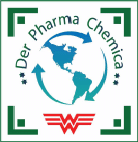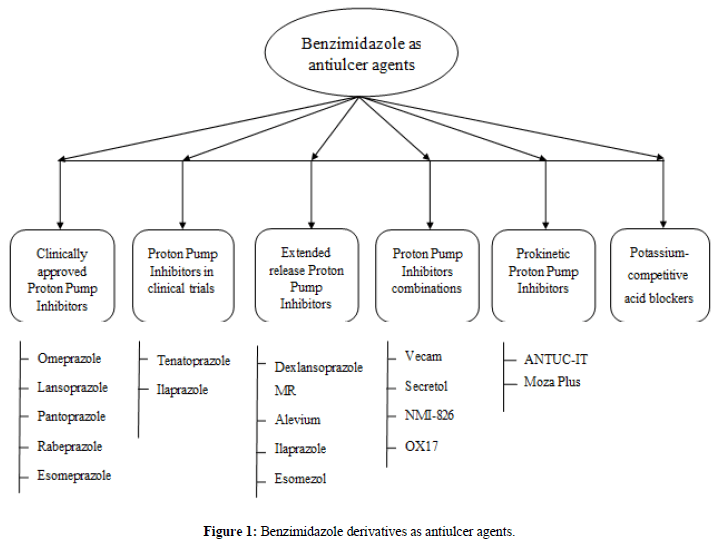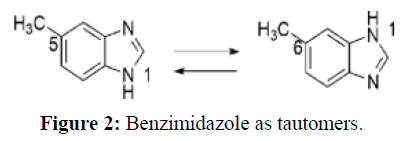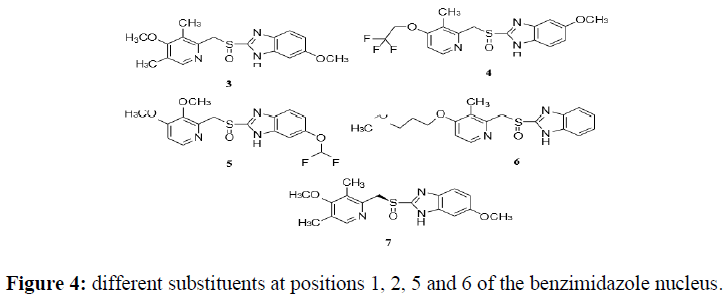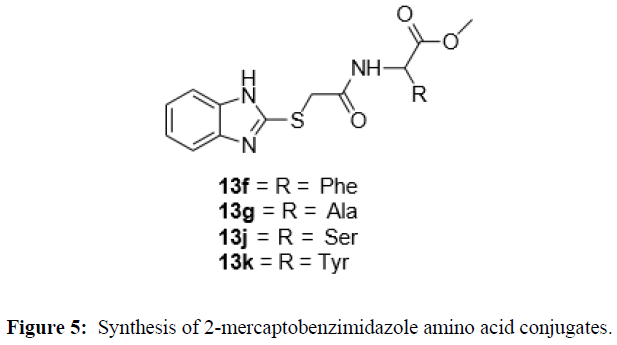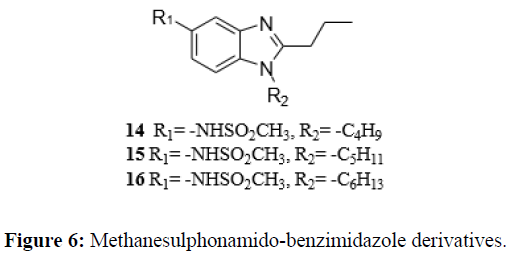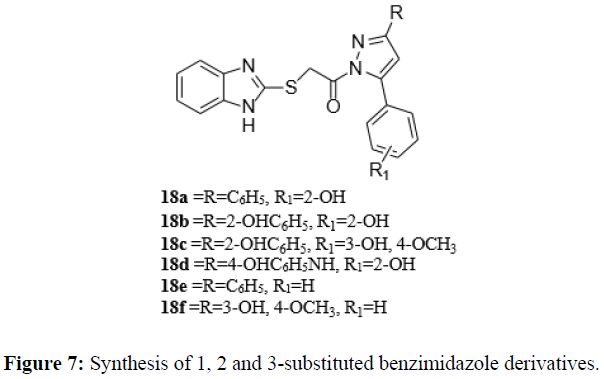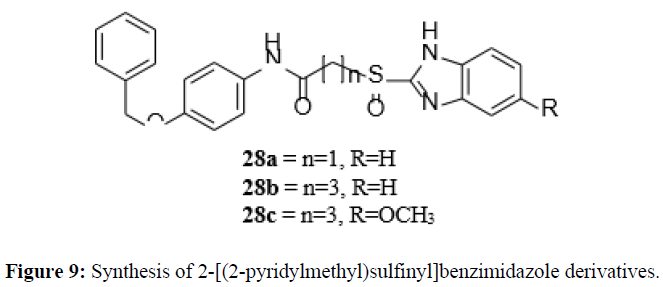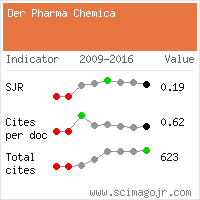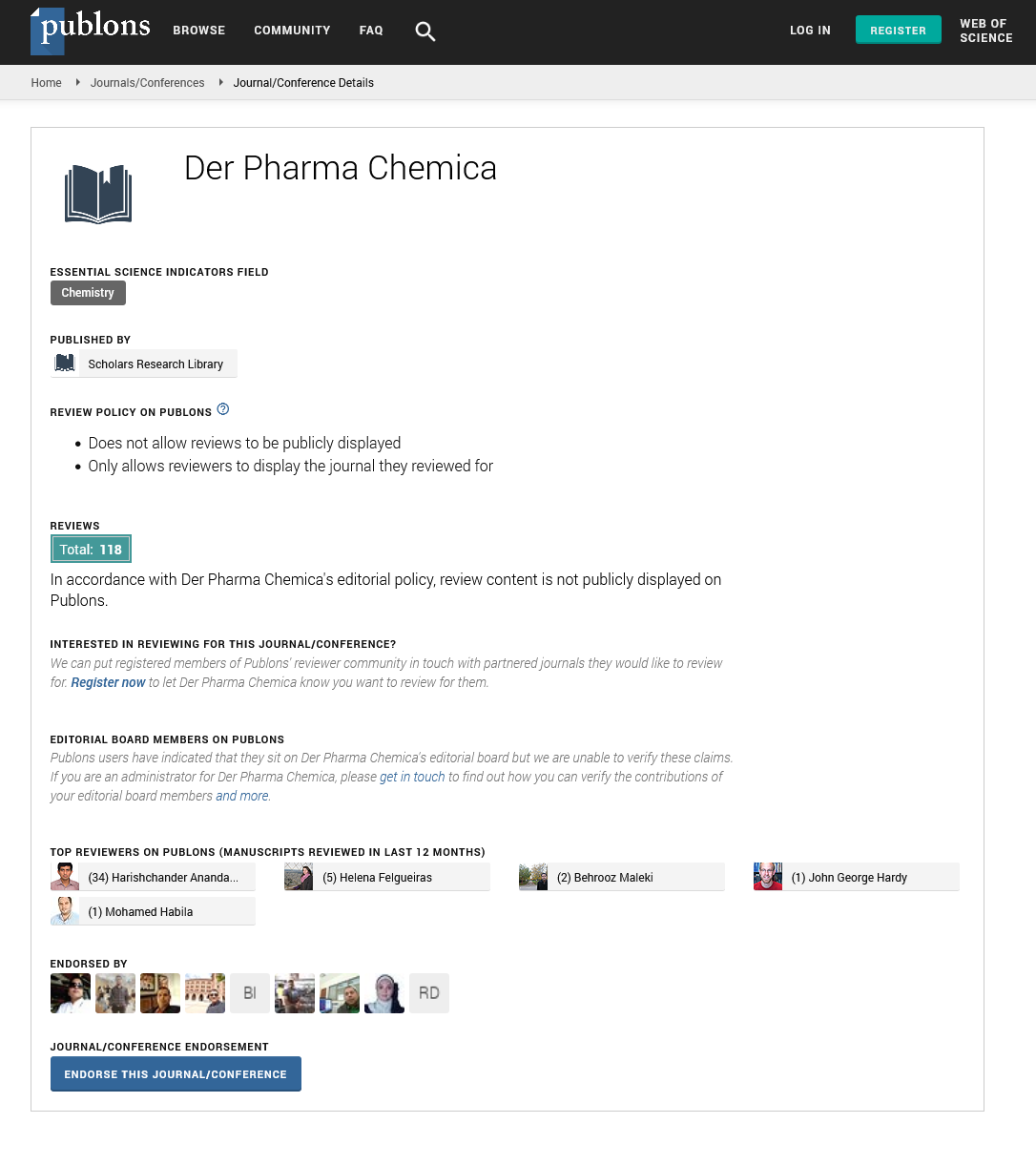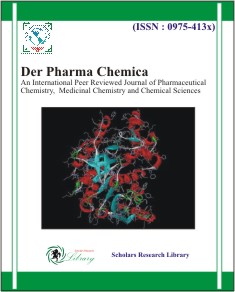Review Article - Der Pharma Chemica ( 2025) Volume 17, Issue 1
Biology and Chemistry of Benzimidazole Derivatives as Antiulcer Agents: A Review
Geeta Yadav*Geeta Yadav, Department of Pharmacy, Chandigarh Pharmacy College (CPC), Punjab, India, Email: yadavgeeta172@gmail.com
Received: 28-Oct-2024, Manuscript No. DPC-23-120498; Editor assigned: 31-Oct-2024, Pre QC No. DPC-23-120498; Reviewed: 14-Nov-2024, QC No. DPC-23-120498; Revised: 01-Feb-2025, Manuscript No. DPC-23-120498; Published: 28-Feb-2025, DOI: 10.4172/0975-413X.17.1.584-591
Abstract
A flexible heterocyclic moiety found in many synthetic and natural compounds is benzomidazole. Because of its wide-ranging effects, it has drawn interest from researchers all around the world for the treatment of many illnesses. Many proton pump inhibitors that have received clinical approval have been available on the market since the discovery of Omeprazole in 1988, which was the first inhibitor based on benzimidazole. But the primary focus of research is on the necessity of pursuing specific goals in order to lessen the adverse effects of proton pump inhibitors. In order to achieve these goals, numerous different proton pump inhibitor medication combinations have also been tested. At the moment, clinical trials are being conducted on a few novel and inventive formulations. In order to set the stage for future investigations, a thorough analysis of antiulcer benzimidazoles was conducted. Researchers and academicians would find this review paper useful in their efforts to create less hazardous and more therapeutically active benzimidazoles. To the best of our knowledge, this study is the first attempt to compile important developments on benzimidazoles that have been suggested as antiulcer drugs. Academics and researchers in the creation of less poisonous, more therapeutically useful benzimidazoles. To the best of our knowledge, this study is the first attempt to compile important developments on benzimidazoles that have been suggested as antiulcer drugs.
Keywords
Benzimidazole; Imidazole; Heterocyclic; Proton pump inhibitors; Clinical drugs
Introduction
The benzimidazole moiety sparked popular interest in 1944 when Woolley's research revealed that it shared structural similarities with biotin and purines, meaning it could function similarly to purines in inducing certain biological reactions. However, Brink later identified 5, 6- dimethylbenzimidaozle as a vitamin B12 degradation product and discovered that several of its derivatives had activity similar to that of vitamin B12. Despite this breakthrough, it was not taken seriously. Certain compounds of substituted benzimidazoles have notable antifungal activity, according to a 1952 study by Jerchel, et al. Due to its structural similarities to several moieties found in vitamins, proteins and nucleic acids, the benzimidazole structure has drawn and continues to draw a great deal of interest from medicinal chemists. Benzimidazoles have a significant role in both synthetic and biological medicinal chemistry approaches. Periodically, a number of review publications on the benzimidazole moiety and its many biological actions are released.
The disorders Zolinger-ellision syndrome, duodenal ulcer, gastric ulcer, gastroesophageal reflux disease and peptic ulcer are becoming more common worldwide, especially in poorer nations. Approximately 10% of the global population is impacted and a survey conducted in 2015 revealed 267,500 deaths [1].
Literature Review
Marshall and Warren made the initial discovery that H. pylori was the cause of peptic ulcers in the late 20th century. Peptic ulcers and chronic gastritis are caused by the gram-negative bacterium Helicobacter pylori, which grows in the mucous layer of the stomach epithelium. Because urease enzyme activity is inhibited, benamidazoles are effective against H. pylori. According to certain published reports, a PPI should be taken in addition to two or three antibiotics for a synergistic effect that will be more successful than H2RAs in eliminating H. pylori.
The stomach secretes a digestive fluid called gastric acid, which is primarily made up of Sodium Chloride (NaCl), Potassium Chloride (KCl) and Hydrochloric Acid (HCl). An essential component of digestion is gastric acid. The mucous secreted by mucous cells creates a protective layer on the stomach cells, preventing the stomach from eroding and is one of the natural defense mechanisms of the stomach. Moreover, the pancreas generates bicarbonate to counteract stomach acid [2].
However, an imbalance between these two variables leads to Zolinger-ellision syndrome, gastroesophageal reflux disease, duodenal ulcers, peptic ulcers and stomach ulcers.
The primary component of gastric juice, hydrochloric acid, is generated by parietal cells. Parietal cells are made up of a vast network of secretory structures called canaliculi, from which hydrochloric acid is secreted into the stomach lumen. Proton pump inhibitors or PPIs, are medications that block the proton pump H+/K+ ATPase, which is primarily responsible for maintaining acidity. The last stage of acid secretion is proton transport by the gastric (H+/K+) ATPase. Because they create an irreversible covalent bond between the enzyme and the cysteine disulphide (-S-S-) bond of H+/K+ ATPase (a proton pump) at the secretary surface of the gastric parietal cell, it was estimated that drugs that inhibit this step could be more effective inhibitors. The only way to start secreting gastric acid again is if new enzymes start to form. The physiological stimulants gastrin, acetylcholine and histamine interact with basolateral parietal cell receptors to regulate gastric acid secretion [3].
The primary working mechanism of Proton Pump Inhibitors (PPIs) is dependent upon three factors. They are firstly weakly basic (pKa 3.8-4.5) because they contain a pyridine group. They are able to accumulate selectively in the highly acidic secretary canaliculus of the parietal cell due to their weak basic nature. The second is the parietal cells' need for an acidic pH. The third step involves the PPIs' activation into their active forms, sulfenic acid and sulfonamide, within the acidic canaliculus environment. The production of gastric acid is inhibited by these active forms because they form disulfide bonds with the cysteins of the H+, K+ ATPase. PPIs are unable to block every gastric pump because not all pump enzymes are always active. They are rapidly metabolized by the liver, giving them short half-lives of 60 to 90 minutes. Only roughly 70% of pumps are inhibited due to their short half-lives and the fact that not all pump enzymes are activated. Because of this, achieving maximum acid suppression requires some time roughly three days. The slow action of gastric acid pumps is caused by the activation of the three previously mentioned factors and the conversion of inactive pumps to active states. Because the PPIs that are currently on the market have issues with chemical instability and half-lives. Thus, there are numerous efforts underway to find novel PPI prodrugs. A number of novel PPIs and their combinations, as well as other benzimidazole derivatives like extended release, are undergoing clinical trials. PPIs, prokinetic PPIs and P-CABs are also in market which are shown in (Figure 1).
For acid-induced ulcers, a variety of therapeutic approaches have been used, including ulcer insulators, antigastrin agents, neutralizing and inhibiting agents and promoters of ulcer healing agents. The focus of this review is on the biological activity of benzimidazole derivatives as antiulcer agents between 2000 and 2017.
Chemistry of benzimidazole
A class of heterocyclic, aromatic chemicals known as benzoimidazole shares a basic structural feature: Six-membered benzene fused to a five-membered imidazole. It contains hydrogen bound to nitrogen at the 1-position, which causes hydrogen to tautomerise in benzimidazole (Figure 2) [4].
These two are tautomers even though they appear to be isomers. A tautomer of 6- methylbenzimidazole is 5-methylbenzimidazole. Ring nitrogens are important because they use a range of forces to interact with different types of receptors and enzymes in biological systems. In benzimidazole, the NH group at position 1 has a weak basicity and is comparatively strongly acidic.
Discussion
Benzimidazole derivatives for ulcer treatment
Benzimidazole derivatives as clinically approved/established drugs: The majority of benzoimidazole derivatives with antiulcer properties are in the class of proton pump inhibitors. In the realm of antiulcer medications, PPIs offer a novel strategy for the efficient suppression of stomach acid production. The first was omeprazole, which was released in 1988. With their SAR study, pantoprazole 5, rabeprazole 6, lansoprazole 3 and omeprazole 4 are now well-established proton pump inhibitors in clinical practice as depicted in (Figure 3) [5].
According to the structure-activity relationship study, strong antiulcer agents have been produced by substituting different substituents at positions 1, 2, 5 and 6 of the benzimidazole nucleus. On the other hand, the nucleus's positions 3, 4 and 7 are empty (Figure 2). Benzimidazole's 1-position can be left unsubstituted or can have aryl or heteroaryl moieties suitably substituted with groups that donate electrons. Similarly, good antiulcer activity is obtained by introducing a long chain of propyl, acetamido, thio, thiazole-amino and tetramethyl piperidine on the pyridine ring at position 2. PPI activity is observed when pyridine is substituted with other heterocyclic compounds such as pyrrolobenzimidazolyl or phenyl isobutyl methylamine. Dimethylimidazopyridine has a potent antisecretory effect. The nucleus's 5 or 6 positions may be unsubstituted or substituents may come from functional groups like halogens. Omeprazole (3) was a breakthrough drug discovered in 1979. It was reported to be the most potent substance and did not cause any significant side effects in the initial animal repeat-dose toxicity studies. Its effectiveness in humans was initially documented in 1983. Literature review shows that in an acidic environment, omeprazole is converted to its sulfenic acid and sulfenamide derivatives, which then form a covalent disulfide bond with the Cys 813 sulfhydral group. Additionally, it was discovered to be beneficial in the management of persistent Zollinger-Ellison syndrome. The most promising antiulcer drug, lansoprazole 4, was discovered by Kubo, et al. in 1990. It possesses cytoprotective, antisecretory and antiulcer properties that outperform those of omeprazole. The drug pantoprazole (5) was produced by substituting certain functional groups on the pyridine ring, such as methyl and trifluoroalkoxy with methoxy. This resulted in a drug with increased stability and potency comparable to omeprazole 3 and lansoprazole 4 (Figure 4) [6].
Through a distinct mode of action, substituted benzimidazoles block the H+/K+ ATPase, the proton pump of the parietal cell. When certain stimuli are present, these substituted benzimidazoles have the ability to prevent the secretion of stomach acid. A study of the relationship between structure and activity has revealed that the sulfoxide group, a heterocyclic methylene group, is crucial for activity as shown in Figure 3.
PPIs are acknowledged as the best treatments currently on the market for conditions linked to acidity. Compared to H2RAs, they offer improved rates of healing and symptom control for both PUD and GERD. However, the drawbacks of a delayed acute effect onset and a slow full effect development led to the adoption of several alternative therapeutic approaches to meet the goal. Among these, the combination of PPIs with other medications, P-CABs and extended release proton pump inhibitors are being processed, as indicated in Table 1.
| Group | Drug | Clinical trials |
|---|---|---|
| PPIs | Ilaprazole | Phase II. Randomized multicenter study |
| Tenatoprazole | Phase III | |
| PPIs combinations | NMI 826 | Phase II |
| OX17 | Phase II | |
| Vecam omeprazole+lansoprazole | Phase I | |
| PPI+alginate | Phase III |
Table 1: PPIs and combination of PPIs in clinical trials.
Extended release proton pump inhibitors
The controlled and prolonged drug release of these PPI formulations with extended release makes them popular. Takeda pharmaceuticals sells the dual delayed-release formulation of dexlansoprazole (the R-enantiomer of lansoprazole), known as dexlansoprazole MR 8. The medication comes in capsule form, each containing two different kinds of granules with a coating that dissolves at a different pH of 6.8 and 5.5, respectively. Unlike other delayed PPIs, it can be taken without consideration for meals [7].
The omeprazole prodrug AGN201904-Z (Alevium) 9 is acid-stable. It therefore has a long plasma half-life and does not need an enteric coating to protect itself from acid. It is quickly hydrolyzed to omeprazole in vivo.
Ilaprazole: Ilaprazole 10, also known as compound IY-81149, shares chemical similarities with lansoprazole and omeprazole. It undergoes extensive metabolism to produce ilaprazole sulfone as the main metabolite. The patent license for ilaprazole in China (license ID: CN 1121714 A) is held by Livzon Pharmaceutical Group Inc. (China), who is currently developing the drug after Il-Yang (South Korea) synthesizes it.
PPI combinations
Proton pump inhibitor-VB101 (Vecam): Omeprazole and succinic acid are combined to create the combination medication Vecam, which causes the parietal cells' proton pumps to open. The administration of PPI without consideration for food is the primary goal. Succinic acid activates proton pumps, which increases PPI's effectiveness.
Secretol: Omiprazole and lansoprazole are combined in the medication known as secretol. Phase II trials are being conducted to compare it to esomeprazole in terms of healing and symptom control for patients with EE (Eosinophilic esophagitis).
NMI-826: Nitric Oxide (NO) and PPI are combined to form NMI-826. It has been discovered that the combination heals stomach ulcers more effectively than a PPI by itself.
OX17: OX17 is omeprazole and famotidine combined. Compared to omeprazole alone, this combination has been shown to be 60% more effective at maintaining intragastric pH levels above 4. Recently, a novel tenatoprazole and H2RA combination was patented [8].
Other benzimidazole analogs as antiulcer agents
Mohd. Saleemuddin Farooqui and Khan Farhan R. created new substituted benzimidazole derivatives and used pharmacological screening to look for H+ K+ ATPase inhibitors and antiulcer properties. Comparing certain compounds to the standard drug, such as 12c (74.03%), 12f (72.87%) and 12i (75.15%), they demonstrated highly significant antiulcer activity; similarly, compound 12c (88.88%), 12d (91.03%), 12f (86.48%) and 12g (84.21%) demonstrated highly significant antisecretory activity.
Khan, et al., synthesized the 2-mercaptobenzimidazole amino acid conjugates and assessed them biologically. Compounds 13f and 13j demonstrated a noteworthy anti-ulcer effect, while compounds 13 g and 13 k demonstrated an anti-secretory effect (Figure 5).
New methanesulphonamido-benzimidazole derivatives were prepared by combining anti-inflammatory and antiulcer drugs, as reported by Sharma, et al. In order to achieve this, the methanesulphonamido function from anti-inflammatory drugs (nimesulide and rofecoxib) and the benzomidazole nucleus from antiulcer medications (lansoprazole, omeprazole and ilaprazole) were combined to create novel compounds with properties and activities from both categories. The compounds 14, 15 and 16 were found in the study to be gastro-sparing anti-inflammatory agents (Figure 6) [9].
In order to test for acute ulcerogenic activity, Ayyad, et al., synthesized a number of novel 1, 2 and 3-substituted benzimidazole derivatives. Compound 17 stood out among the series as a noteworthy compound that lacked any irritating qualities for the stomach. Six unique benzimidazole-pyrazole hybrids 18a, 18b, 18c, 18d, 18e and 18f were created and tested by Noor, et al. for their anti-ulcer properties. The outcomes showed strong antiulcer activity when compared to Omeprazole, the typical medication. The antiulcer activity was proposed by SAR research in connection with the substitution pattern on the two aromatic rings that are joined to the pyrazole ring. In order to determine how well these novel hybrid molecules interacted with the target H+/K+ ATPase compared to omeprazole, docking studies were also conducted. The Lipinski rule of five was used to evaluate the drug-likeness of molecules (Figure 7) [10].
Madala and Anusha recently created hybrid benzimidazole derivatives by combining pyridine derivative with 1-methyl-2-mercapto-5-nitro-1H-benzimidazole and they then tested the compounds' anti-ulcer properties biologically. The gastroprotective potential of compound 19 was demonstrated by the results and SAR study. This is believed to be because the compound has hydrophobic moieties and less steric hindrance surrounding the pyridine ring.
A novel benzimidazole derivative was reported by Reddy, et al., who also evaluated its impact on the development of ulcers and the release of gastric acid in rats. The importance of compound 20, which offers defense against ulcers brought on by pylorus ligation, was demonstrated by the results.
Arora, et al. synthesized some new coumarin-benzimidazole derivatives, taking into consideration the anti-inflammatory properties of 3-substituted coumarins and the antiulcer activity of 2- substituted benzimidazole. An assessment of the ulcer index revealed that substances 21 and 22 are safe for the stomach mucosa.
A number of substituted 2-(pyrimidinylsulfinyl) benzimidazole derivatives were reported by Khan FR and their antiulcer and antisecretory properties were assessed. Early investigations revealed that compounds 23c and 23d demonstrated strong antisecretory activity, while compounds 23a, 23b and 23d had good antiulcer activity with decreased toxicity (Figure 8).
Analogs of benzoimidazole piperazine conjugated compounds were reported and their in vivo antiulcer activity was evaluated. Out of all the synthesized analogs, compound 24 exhibited the strongest antiulcer properties. To determine the function of various functional groups accountable for increased activity, SAR research was also conducted. It was revealed that the activity of the 4-methoxy phenyl substituted for piperazine and attached to the benzimidazole moiety was caused by its electron-donating property.
A group of 3,4,5-trimethoxybenzylbenzimidazole derivatives with anti H. pylori activity were reported by Chang, et al. Compound 2-fluorophenyl-5-methyl-1-(3,4,5-trimethoxybenzyl) benzimidazole 25, the most potent of the series, was found. Additionally, an in vitro investigation revealed its mode of action, which involved FMTMB preventing H. pylori from adhering to and invading gastric epithelial cells.
By inhibiting stomach H+/K+ ATPase, derivatives made from pyrimidine and benzimidazoles were assessed for their antiulcer and antisecretory properties. The control dose was acetylsalicylic acid. When compared to the standard medication pentaprozole, sulfoxides 26(a-d) demonstrated good antiulcer activity with lower toxicity and compound 26(c,d) demonstrated good antisecretory activity.
Yan, et al. reported and screened a series of 2-[(2-pyridylmethyl)sulfinyl]benzimidazole derivatives for H+/K+ ATP enzyme inhibitors in 2011. Compound 27 showed notable in vitro activity within the series, with an IC50 value within the range of 1.6 × 10−5 M when compared to the reference medication, omeprazole.
Six novel 2-substituted mercaptobenzimidazole derivatives were synthesized and assessed for their antiulcer activity by Reddy, et al. Of these, it was discovered that compounds 28a, 28b and 28c had significantly lower pH, gastric secretion volume, ulcer score and free and total acidity (Figure 9).
Using the benzimidazole and quinazoline moieties, some novel compounds were created and their antiulcer activity was assessed against ulcers caused by pylorus ligation, aspirin and ethanol in rat models. A study comparing compounds 29(a,b) to the medicine Omeprazole at doses of 10 and 20 mg/kg demonstrated the compounds' strong activity. Remarkably, the SAR study stated that the dimethoxy phenyl with difluromethoxy and the benzimidazole sulfinyl methyl quinazoline substituted with 3-N pyrazine had the highest activity.
Conclusion
Even though significant progress has been made in understanding the pathways leading to the release of acid secretion, new antiulcer drugs with minimal side effects have not yet been found. To treat disorders linked to acid secretion, a variety of clinically approved antiulcer medications (PPIs) and their creative combinations with other medications are being marketed. There is ongoing research that could result in novel and effective pharmaceutical discoveries.
References
- Woolley DW. J Biol Chem. 1944;152: p. 225-232.
- Brink NG, Folkers K. J Am Chem Soc. 1949; 71(8): p. 2951.
- Jerchel D, Fischer H, Kracht M. Liebigs Ann Chem. 1952; 575(2): p. 162-173.
- Alaqeel SI. J Saudi Chem Soc. 2017; 21(2): p. 229-237.
- Shaharyar M, Mazumder A. Arabian J Chem. 2017; 10: p. 157-173.
- Song D, Ma S. ChemMedChem. 2016; 11(7): p. 646-659.
- Keri RS, Hiremathad A, Budagumpi S, et al. Chem Biol Drug Des. 2015; 86(1): p. 19-65.
- Yadav G, Ganguly S. Eur J Med Chem. 2015; 97: p. 419-443.
- Fei F, Zhou Z. Expert Opin Ther Pat. 2013; 23(9): p. 1157-1179.
- P Barot K, Nikolova S, Ivanov I, et al. Mini Rev Med Chem. 2013; 13(10): p. 1421-1447.
